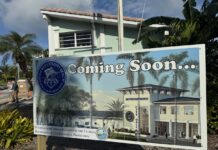
We hear them more often than we see them, depending on weather and altitude, but their sound is unmistakable, approaching as it does like a rising wall of power that, yes, interrupts the occasional phone call, but never fails to impress.
We all look up when we hear, then see, the familiar silhouette of fighter jets cutting across the Florida Keys sky, independently or in pairs, their speed outrunning their sound. And after a few years of residency here, we all draft our own improvised, though perhaps less than accurate, version of what these planes and their pilots are doing in the blue sky above our island chain.
But how much do we civilians actually know about the F-5 Tiger-II fighter jets and their pilots that are a permanent feature in the Lower Keys at Boca Chica Field and Naval Air Station Key West?
“I’ve heard people say the craziest things about what we do here,” said Cmdr. Matt Pearce, public affairs officer for VFC-111, the resident adversary squadron at Naval Air Station Key West. “One person swore we were practicing dropping bombs. I promise that’s not the case. Never. Ever. Ever.”

VFC-111 is the home team around here. Except they play the bad guys. As an adversary squadron, the pilots of VFC-111 are the instructors who play the enemy during crucial air-to-air combat training.
The squadron acquired the moniker Sun Downers when established during World War II.
But let’s be real, my fellow children of the ’80s. Unless we’ve served in the military, we learned everything we know about “air combat maneuvering — dogfighting,” from the 1986 movie “Top Gun.”
So to put it in familiar terms, VFC-111 pilots are Viper and Jester, seasoned and expert mentors challenging the aviators they train and presenting new situations for them to handle.
The Keys Weekly recently caught up with Cmdr. Pearce, who showed us around Boca Chica airfield, the jet hangar, their “ready room” for pre- and post-flight briefings, and their classrooms, complete with those miniature models of jets attached to sticks so pilots can twist, turn and invert them, mimicking aerial maneuvers in a classroom.

The VFC-111 instructors fly their F-5 Tiger-IIs against F-22s, F/A-18 Super Hornets, F-22 Raptors and other fighter jets from other squadrons that visit NASKW, usually for two weeks at a time to train with VFC-111 and take advantage of Key West’s flight-friendly weather and conveniently located air space, said Pearce, who owns a home, and is raising his kids, in Key West.

I swear, I had every intention of conducting a professional interview with Pearce, taking notes and asking intelligent questions while zipping around the airfield with him on a golf cart. But then, something happened. I turned into a wide-eyed groupie and the “Top Gun” influence took over.
As surely as someone of our generation will sing the name “Roxanne” in the same shrill voice as the Police song, someone else will make “Top Gun” references when touring a naval air station. There’s the requisite, “Negative, Ghost Rider, the pattern is full,” among plenty of others.
I won’t deny it. I was that guy a few weeks ago. Let’s just say my enthusiasm eclipsed my professional intentions for an hour or so. Thankfully, Pearce is a skilled aviator and instructor and an enthusiastic tour guide, eager to let the Keys community know who VFC-111 is and what they do just up the road.
Many of the Sun Downers live here. Some are reservists, no longer on active duty, but still eager to do what they love and teach what they’ve learned. While some of the fighter pilots have made Key West and the Lower Keys their permanent homes and get involved in the community, others commute from as far away as Salt Lake City, Utah to pursue their passion as fighter pilots and train the next generation of young lions in the fleet, said CDR Derek “Baffle” Ashlock, commanding officer of VFC-111.
These guys have the coolest job on the planet, though I’m admittedly biased. I still smile at the memory of my once-in-a-lifetime Blue Angels flight in 2006. I spent 45 minutes in an F/A-18 Hornet and loved every second of every maneuver — the vertical takeoff, the inverted flight, weightlessness, supersonic speeds, you name it. I proudly remained conscious as the pressure of 7.4 Gs tried to push all the blood from my brain to my legs. I didn’t throw up. I didn’t wet my pants. I did, however, ask my pilot to marry me sometime between our vertical takeoff and our first inverted maneuver.
Godspeed, guys, and thank you for your service.
(Now, if I could just get Kenny Loggins’ “Danger Zone” out of my head — Revvin’ up your engine / Listen to her howlin’ roar / Metal under tension / Beggin’ you to touch and go / Highway to the danger zone….)

























